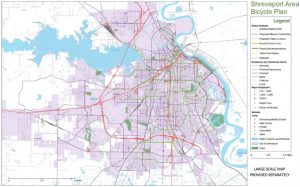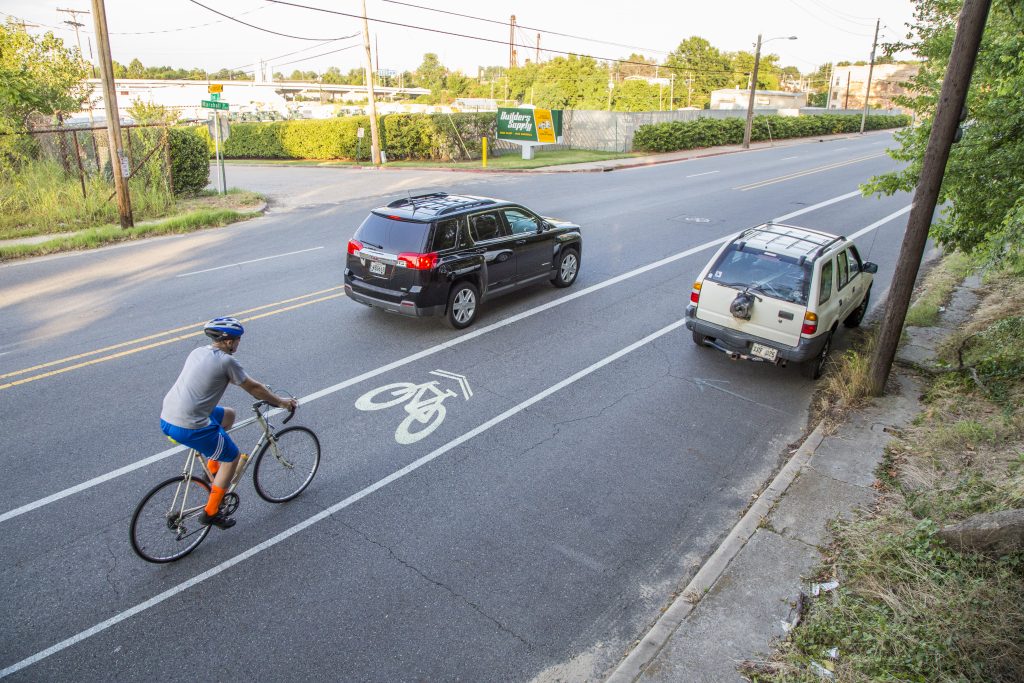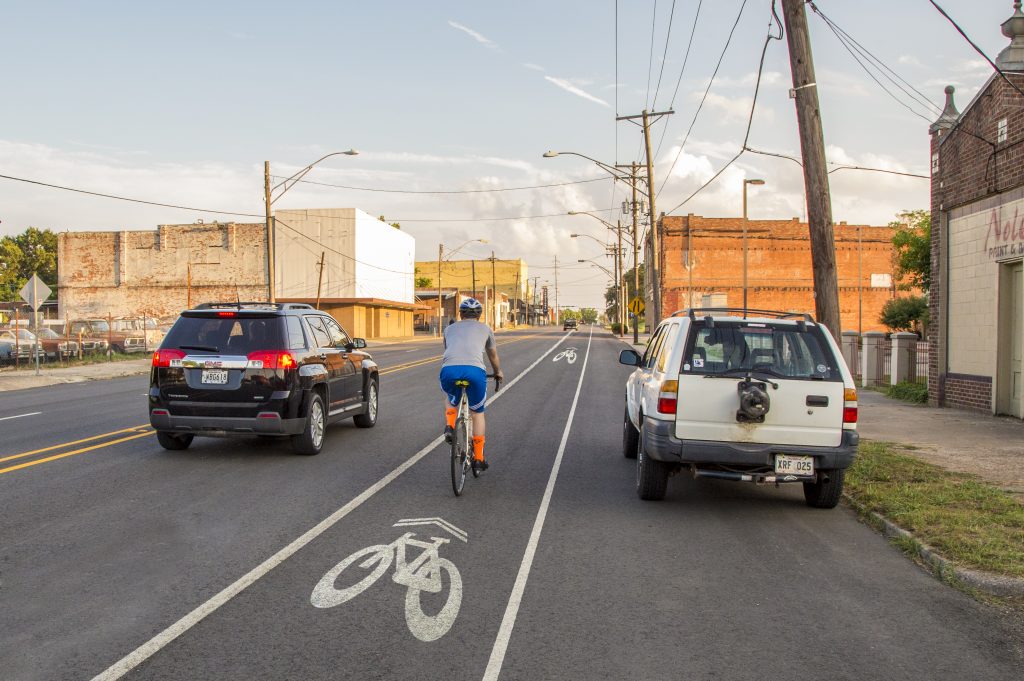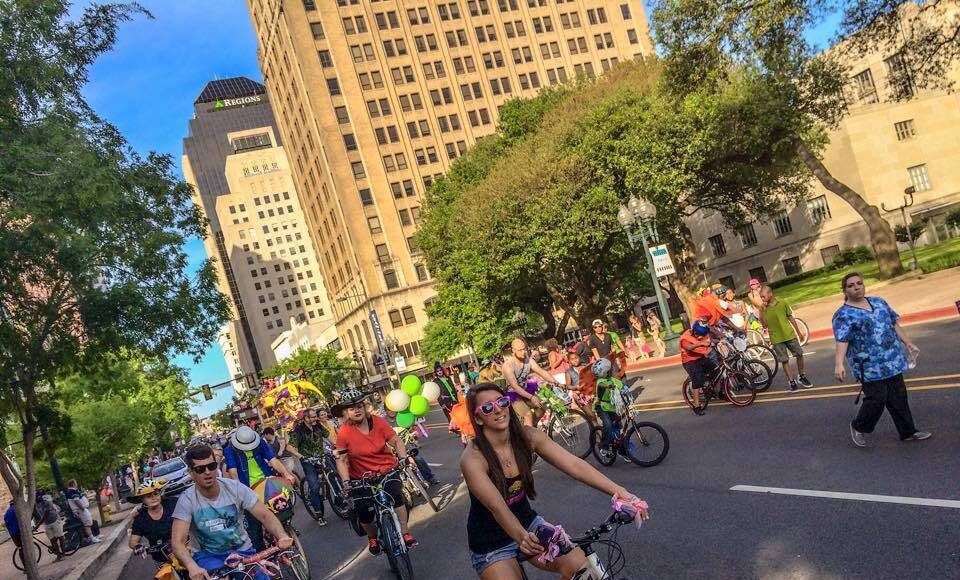Tim Wright contributed to this article.
Disclosure: Madison works for the Shreveport Regional Arts Council, which is a separate 501(c)3 organization than Shreveport Common, but the entities partner frequently. Tim works for Halff Associates, who employs Bud Melton, who put together the Caddo Parish Bike Plan while at Bowman-Melton Associates.

You may have heard: Caddo Commission passed a bike plan! But, what policy did they pass exactly? What does that mean for us two-wheel-travelers?
Biking is healthy, environmentally-sound, and fun. Safe bike paths are key in equitable transportation systems for lower income travelers and fundamental “quality of life” amenities for professionals. Yet, it is not “as easy as riding a bike” to build hundreds of interconnected miles of bike paths across Caddo Parish.
Three different entities, Shreveport Common, Caddo Parish, and the City of Shreveport are bringing our bicycle and pedestrian infrastructure into the 21st century behind-the-scenes, all in the face of limited financial resources and an ingrained car-centric culture. These three entities are working within the same bicycle map framework, yet on their own timeline and utilizing different funding strategies within their respective jurisdictions.
Much like a bike wheel or concentric circles, the Shreveport Common “hub” starts Downtown; the City of Shreveport will implement “spokes” going out from downtown across the City; then Caddo Parish will oversee remaining non-municipal roads within Caddo Parish.
Heliopolis spoke to Wendy Benscoter (Shreveport Common), Matthew Linn (Caddo Parish Commission), and Jeff Everson (Shreveport City Council) about bicycle path funding and next steps. The following is a summary from these sources.
Shreveport Common as a “Hub”
In 2012, the Shreveport Common team, under the Shreveport Regional Arts Council, started a series of Community Task Force workgroups to analyze community needs within the 9-block area of downtown poised for revitalization. Now its own 501(c)3 nonprofit, Shreveport Common organized local experts to research topics such as “Social Services” and “Parks and Transportation” over nine months.
The “Transportation” Task Force recommended creating a truly walkable and bikeable neighborhood; at the same time bicycle community stakeholders sought an easily accessible, low-traffic area to connect paths downtown. Within this synergy, a pilot project took form.
Community representatives, such as Maurice Loridans, as well as experts, like APA Transportation Planner Chris Petro with Northwest Louisiana Council of Governments (NLCOG), created the “Shreveport Common Bicycle and Pedestrian Path Plan,” which was later approved by the City and the Department of Transportation. This plan seeks to connect a handful of priority, nearby destinations, such as C.C. Antoine Park in Allendale (1717 Poland St.), the Riverfront, the coming Intermodal Bus Station, LSUS-HSC, and Centenary College.
Today, the plan is moving forward. The Louisiana Department of Transportation and Development (LaDOTD) has reserved $150,000 for construction in conjunction with NLCOG. In order to have these funds released, the Shreveport Common team is pulling together (and working to fund) a committee of street planners – and even a few local artists – to create the required set of final implementation strategies. This means that the group will analyze details like how parking a car would interact with a bike lane or how to reconfigure a specific sidewalk curb for safety.
The staff hopes to complete the first stretch of a working bike path next summer. The most likely first path “on deck” will connect C.C. Antoine Park and (the coming) Intermodal Bus Station to the Riverfront by way of the Shreveport Common district. If completed, Milam St, Texas Ave., and Crockett St. would include the first urban, on-street bike paths in Shreveport.

Caddo Parish as the “Outer Ring”
Starting in late 2014, NLCOG, the Metropolitan Planning Organization, was working on the next 10 year transportation study, which would be locked into law by the federal government. Local super heroes Ila Broyles and Stephen Pederson stepped in to work with Caddo Commissioner Matthew Linn to include and fund critical pieces needed for a full multimodal infrastructure plan, such as bike lanes and education for workforce mobility.
The “2015 Caddo Parish Bicycle Plan” was prepared for the regional, long-range transportation plan. Then, the Caddo Commission sought to use this plan as a guide to apply for $400,000 of United States Department of Transportation (USDOT) funding, where federal and local entities split project costs 80/20, respectively. At the meeting on August 18, 2016, the Commission voted to (a) approve $10,000 for expenses and fees needed to prepare an application for federal funding through the LaDOTD Transportation Alternatives Program (TAP), and (b) to lay the groundwork for the Parish’s 20% match of future federal support.
The amount requested from the USDOT, $400,000, plus the Parish’s contribution, will take the Parish’s Bike Plan through Phase I. Separate bike lanes across hundreds of miles in our Parish are still decades away, but Phase I will bring bicycle signage and education to connect communities, schools, and tourist destinations in a new way.
The Parish plan submitted to the USDOT – and it’s critical 80/20 money split – can be utilized by municipalities Greenwood, Vivian, Belcher, Keithville, and Shreveport, but these municipalities – including the City of Shreveport – oversee implementing changes within their own city limits.

City of Shreveport: The Missing Spokes
On the City’s side, progress is a little harder to come by. As the missing link between the “hub” of downtown and outlying Caddo Parish areas, it is key that the City also get on board the bike train.
A funding proposal similar to the Parish’s was suggested to the City, but funds were not allocated towards such an application. This was due to (a) the LaDOTD Transportation Alternatives Program’s impending October deadline, (b) a desire to not compete with Parish funds for the current proposal, and (c) the lack of current funding that could be allocated to bicycle infrastructure.
The reality is, the Parish has led the charge on bicycle planning, and the City of Shreveport has already allocated funding towards infrastructure projects which don’t include bicycle infrastructure. Since most of the city’s funds have already been allocated towards other infrastructure projects, any 80/20 funding proposal would be automatically rejected due to the lack of money set aside for the proposed bike infrastructure.
However, Councilman Everson assured that there is progress. Legislation is being drafted to support the Bike Plan and should appear on the next agenda. This would increase the priority of bicycles in future infrastructure funding. Everson also mentioned that actions such as the a resolution supporting the Parish Bike Plan and advocacy work from groups such as Bike Shreveport helps to show city officials specific ways in which the city can better accommodate bicycles.

Moving Forward
To keep the conversation moving forward, invest your time and money into diverse, dense areas of Shreveport. If you would allow me (Tim) to get a tad nerdy for a second, there’s an idea in planning that transportation and land use are two sides of the same coin. That is, the way we use our land dictates the modes of transportation we need. The need for bicycle infrastructure makes infinitely more sense in a denser urban area than in a sprawling land of strip malls and segmented subdivisions. So, in addition to spending your own money appropriately, support legislation and development that leads to a more compact and centralized city.
Additionally, practice good etiquette while reclaiming the road. As bikers, we represent the future of bicycling to our fellow voters! Stay in one (the farthest right) lane and obey the same laws as drivers, like respecting another’s right-of-way and signalling to turn. As a driver, the rule of thumb is to “leave 3 feet” between your car and a biker, but I (Madison) feel least likely to die when my bike and I have a whole lane to ourselves.
As with any issue, communicate with your local elected representatives! Recently, Commissioner Middleton decided to vote for the Bike Plan, in part, because of the number of emails and calls he received on the issue. Our local politicians are receptive to what you think! Take time to thank our champions, like Matthew Linn, Jeff Everson, and Steven Jackson, and reach out to others and explain your views on this issue and others.
Most importantly, keep your #buttsonbikes!



